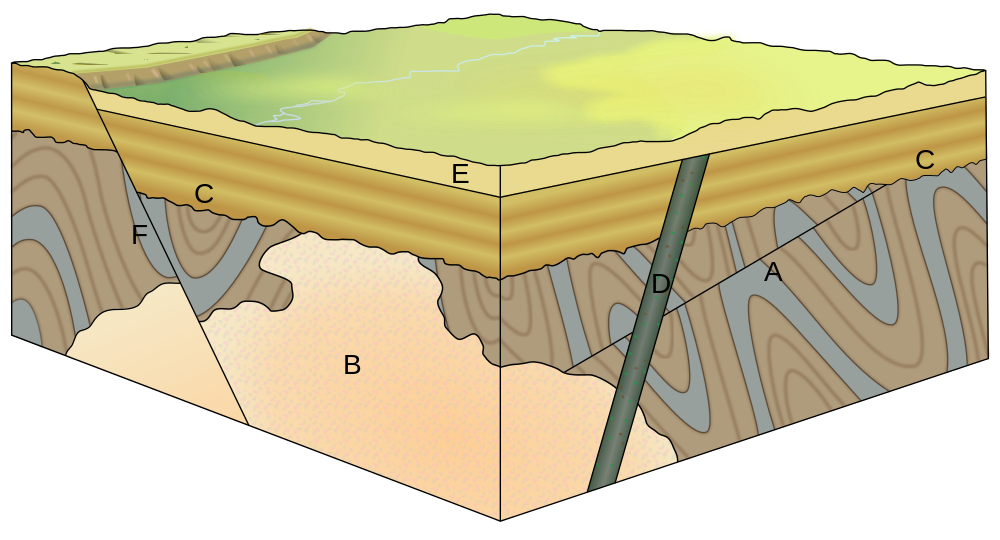9.2: Assignment- Relative Dating and Cross Cutting Relationships
- Page ID
- 6097
Module 9 Assignment
Relative Dating and Cross Cutting Relationships

Overview
Well known for its geologic significance, the Grand Canyon is one of the most studied geologic landscapes in the world. It offers an excellent record of three of the four eras of geological time, a rich and diverse fossil record, a vast array of geologic features and rock types, and numerous caves containing extensive and significant geological, paleontological, archeological and biological resources. It is considered one of the finest examples of arid-land erosion in the world. The Canyon, incised by the Colorado River, is immense, averaging 4,000 feet deep for its entire 277 miles. It is 6,000 feet deep at its deepest point and 15 miles at its widest. The image below shows the layers of rock that are exposed in the canyon.

This is a geologic cross section (not drawn to scale) that shows the stratigraphy of the Grand Canyon. In other words, it represents what the rock layers would look like if you took a knife and sliced down through the Earth at a given location, like a piece of cake. You are viewing those layers from the “side” of the piece of cake in this image. Note that all three types of rock (sedimentary, metamorphic, and igneous) are present in this cross section. Note how the ages of the rock decrease in age from the bottom to the top. If it weren’t already labeled, do you think you would be able to spot the Great Unconformity near the bottom of the canyon?
How Old is the Grand Canyon? (optional)
Listen to scientists talk about the age of the Grand Canyon and the controversy over the dating. Press the play button on the left of the page to listen. (Transcripts available on the left menu as well.)
Grand Canyon May be Older (and Younger) than you think.
Check out Basic Answers to your Geologic Questions.
This accompanying informational document comes from the Grand Canyon Guide newspaper, published by the Grand Canyon National Park.
Instructions
You will be determining the relative order in which geological events occurred, as shown in this generic stratigraphic cross section (below). Stratigraphy is the study of the rock strata, or layers, and is usually applied to sedimentary (and sometimes volcanic) rocks.

- Study the 3-D cross section above. The cross section contains evidence of folding in layer G (a squeezing of the rock due to compression— we’ll learn more about that in module 11) and faulting among the various rock layers.
- What rock type(s) are represented in each of the layers B, G, D, E (sedimentary, igneous, or metamorphic)? Explain how you determined this.
- What type of unconformity does C represent? Explain. (Hint: Your choices are disconformity, nonconformity, angular unconformity, or paraconformity.)
- To which letter(s) or layer(s) of rock does the Principle of Superposition apply, and why? Explain.
- Write the order in which each lettered event (A-H) occurred in the sequence, from oldest to youngest. (Hint: Remember that A and F are fault lines, D is a dike, and C is an unconformity.)
- At what point in the sequence do you think the folding of unit G took place, and why? Explain.
- In 3 – 4 sentences, describe how the Law of Cross Cutting Relations applies to the cross section and the sequence in which you ordered the events.
- Do some searching on the Internet (or elsewhere) to find another simple geologic cross section of your choice.
- Include an image of this cross section in your write-up, and describe the order in which events occurred in the section.
- Please put labels on your cross section if it does not already have them, so that it is clear which events you are referring to.
- Cite your source for the cross section, please!
Grading Rubric
10 points: All questions were answered thoroughly and accurately. Complete sentences were used to answer the sample questions.
8 points: All questions were answered and were mostly accurate. Only two or three minor errors.
5 points: Answers were too brief and 1 – 2 questions were unanswered.
2 points: Only very partial information provided.
0 points: Did not complete the assignment.

